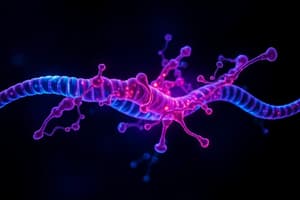Podcast
Questions and Answers
What is the effect of histone phosphorylation on chromatin structure?
What is the effect of histone phosphorylation on chromatin structure?
- It relaxes chromatin structure
- It regulates chromatin condensation (correct)
- It has no effect on chromatin structure
- It compacts chromatin structure
What is the result of adding an acetyl group to lysine residues on histone proteins?
What is the result of adding an acetyl group to lysine residues on histone proteins?
- It reduces accessibility to transcription factors
- It increases electrostatic attraction to DNA
- It has no effect on chromatin structure
- It neutralizes positive charge on histones (correct)
What is the primary function of histone ubiquitination?
What is the primary function of histone ubiquitination?
- To relax chromatin structure
- To play a role in DNA repair and transcriptional regulation (correct)
- To regulate gene expression
- To regulate chromatin condensation
What is the purpose of chromatin remodeling?
What is the purpose of chromatin remodeling?
What is the effect of histone methylation on gene expression?
What is the effect of histone methylation on gene expression?
Which histone modification is associated with constitutive heterochromatin formation?
Which histone modification is associated with constitutive heterochromatin formation?
What is the function of histone methyltransferases (HMTs)?
What is the function of histone methyltransferases (HMTs)?
Which histone modification is a hallmark of mitosis?
Which histone modification is a hallmark of mitosis?
What is the result of chromatin remodeling?
What is the result of chromatin remodeling?
Which histone modification is typically associated with active transcription?
Which histone modification is typically associated with active transcription?
Study Notes
Histone Modifications
Histone modifications are covalent post-translational modifications (PTMs) that alter chromatin structure and function, influencing gene expression.
Histone Phosphorylation
- Addition of a phosphate group to histone proteins
- Regulates chromatin condensation and chromosome segregation during mitosis
- Phosphorylation of histone H3 at serine 10 (H3S10ph) is a hallmark of mitosis
- Involved in DNA repair and gene regulation
Histone Acetylation
- Addition of an acetyl group to lysine residues on histone proteins
- Neutralizes positive charge on histones, reducing electrostatic attraction to DNA
- Relaxes chromatin structure, increasing accessibility to transcription factors
- Associated with transcriptional activation and gene expression
Histone Ubiquitination
- Covalent attachment of a ubiquitin protein to histone proteins
- Plays a role in DNA repair, transcriptional regulation, and chromatin remodeling
- Histone ubiquitination can either activate or repress gene expression
- Targets histone H2A and H2B
Chromatin Remodeling
- Active reorganization of chromatin structure to alter accessibility to DNA
- ATP-dependent and ATP-independent remodeling complexes exist
- Involved in transcriptional regulation, DNA repair, and chromatin maintenance
- Remodeling complexes can either relax or compact chromatin
Histone Methylation
- Addition of a methyl group to arginine or lysine residues on histone proteins
- Can be associated with either gene activation or repression
- Histone methyltransferases (HMTs) catalyze the reaction
- Different methylation sites and degrees of methylation have distinct functions:
- H3K4me3: typically associated with active transcription
- H3K27me3: typically associated with repression
- H3K9me3: associated with constitutive heterochromatin formation
Histone Modifications
- Covalent post-translational modifications that alter chromatin structure and function, influencing gene expression
Histone Phosphorylation
- Involves the addition of a phosphate group to histone proteins
- Regulates chromatin condensation and chromosome segregation during mitosis
- Phosphorylation of histone H3 at serine 10 (H3S10ph) is a hallmark of mitosis
- Involved in DNA repair and gene regulation
Histone Acetylation
- Involves the addition of an acetyl group to lysine residues on histone proteins
- Neutralizes positive charge on histones, reducing electrostatic attraction to DNA
- Relaxes chromatin structure, increasing accessibility to transcription factors
- Associated with transcriptional activation and gene expression
Histone Ubiquitination
- Involves the covalent attachment of a ubiquitin protein to histone proteins
- Plays a role in DNA repair, transcriptional regulation, and chromatin remodeling
- Can either activate or repress gene expression
- Targets histone H2A and H2B
Chromatin Remodeling
- Active reorganization of chromatin structure to alter accessibility to DNA
- ATP-dependent and ATP-independent remodeling complexes exist
- Involved in transcriptional regulation, DNA repair, and chromatin maintenance
- Remodeling complexes can either relax or compact chromatin
Histone Methylation
- Involves the addition of a methyl group to arginine or lysine residues on histone proteins
- Can be associated with either gene activation or repression
- Histone methyltransferases (HMTs) catalyze the reaction
- Different methylation sites and degrees of methylation have distinct functions:
- H3K4me3: typically associated with active transcription
- H3K27me3: typically associated with repression
- H3K9me3: associated with constitutive heterochromatin formation
Studying That Suits You
Use AI to generate personalized quizzes and flashcards to suit your learning preferences.
Description
This quiz covers histone modifications, including phosphorylation and acetylation, and their roles in chromatin structure, gene expression, and DNA repair.



